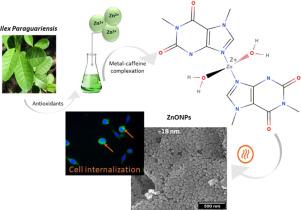Nano-Structures & Nano-Objects Pub Date : 2020-08-24 , DOI: 10.1016/j.nanoso.2020.100532 Marina Bandeira , André L. Possan , Sandra S. Pavin , Camila S. Raota , Mario C. Vebber , Marcelo Giovanela , Mariana Roesch-Ely , Declan M. Devine , Janaina S. Crespo

|
Zinc oxide nanoparticles (ZnONPs) was produced using Ilex paraguariensis (mate) leaves extract using a green synthesis process. The influence of ethanolic and aqueous plant extract and zinc source on the green synthesis of ZnONPs was studied. Cyclic voltammetry and Fourier transform infrared spectroscopy (FTIR) were used for the assessment of the mechanism route of ZnONPs while the formation of this nanomaterial was confirmed by X-ray diffraction (XRD) analysis. The morphology and size of the ZnONPs synthesized were evaluated using field emission scanning microscopy (FESEM) and transmission electron microscopy (TEM) analysis. In general, all different synthesized ZnONPs exhibited a hexagonal crystalline structure whereas the size and shape varied depending on the extract and zinc salt used. Nonetheless, the most uniform and smallest ZnONPs were obtained using ethanolic extract and zinc nitrate, showing spherical morphology and a diameter of about 18 nm. With the use of cyclic voltammetry and FTIR analysis, it was concluded that the formation of ZnONPs through green synthesis occurred due to complexation of Zn(II) ions by antioxidants compounds present in the Ilex paraguariensis extract and further thermal degradation of the complexes. Concerning the cytotoxicity assays, the L929 cell viability decreases in a dose-dependent manner for all samples tested. In general, nanoparticles with reduced size and uniform shape exhibited no cytotoxic effects up to a concentration of 10 g mL−1. However, higher ZnONPs concentrations caused a decrease in cell viability. This was possibly due an autophagic induction process triggered by the internalization of the nanomaterial. Finally, this work provides a better understanding of the mechanism route to obtain ZnONPs via green method and their potential to be used as a biomedical material.
中文翻译:

从巴拉圭冬青树叶提取物中获得的绿色合成氧化锌纳米粒子的形成,表征和细胞毒性的机理
氧化锌纳米颗粒(ZnONPs)是使用Paraguariensis(伴侣))叶提取物采用绿色合成工艺。研究了乙醇和水生植物提取物以及锌源对ZnONPs绿色合成的影响。循环伏安法和傅里叶变换红外光谱(FTIR)用于评估ZnONPs的机理路线,同时通过X射线衍射(XRD)分析确认了该纳米材料的形成。使用场发射扫描显微镜(FESEM)和透射电子显微镜(TEM)分析评估合成的ZnONP的形态和尺寸。通常,所有不同的合成ZnONP都显示六边形晶体结构,而大小和形状则取决于所用的提取物和锌盐。尽管如此,使用乙醇提取物和硝酸锌仍可获得最均匀,最小的ZnONP,呈球形,直径约18 nm。使用循环伏安法和FTIR分析,得出的结论是,通过绿色合成形成ZnONP的发生是由于Zn(II)离子被存在于水中的抗氧化剂化合物络合所致。巴拉圭冬青提取物和复合物的进一步热降解。关于细胞毒性测定,对于所有测试样品,L929细胞活力以剂量依赖性方式降低。通常,尺寸减小和形状均匀的纳米颗粒在浓度高达10时都没有细胞毒性作用g mL -1。但是,较高的ZnONPs浓度会导致细胞活力下降。这可能是由于纳米材料的内在化引发的自噬诱导过程。最后,这项工作更好地了解了通过绿色方法获得ZnONP的机理途径及其作为生物医学材料的潜力。


























 京公网安备 11010802027423号
京公网安备 11010802027423号